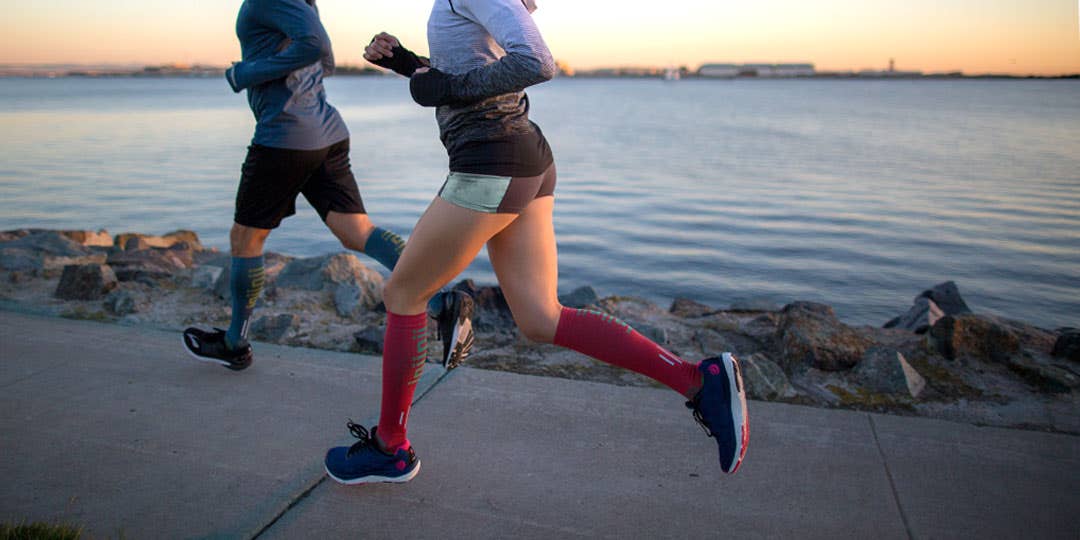Winter is right around the corner, and while daylight savings can push your evening running routines into the dark, don’t let it stop you from getting outside! This November, Injinji is celebrating National Running Safety Month by bringing you tips on how to run safer through the darker fall and winter months.
Why do we celebrate National Running Safety Month? Well, because we love running! As a group of runners and outdoor enthusiasts ourselves, we want running to be as safe and enjoyable as possible for everyone in our great community. We believe that you can stay safe and benefit from the physical, mental and emotional benefits that exercise give you – even when running at night.
Whether you run in lively city parks, quiet neighborhoods or sprawling trails, these running safety tips will encourage you to keep getting out there after the sun has set!
- Be Aware of Your Surroundings
This is probably the best piece of advice we could give runners – day or night. While being cautious doesn’t guarantee an accident or bad situation won’t occur, you should be aware of any strange or abnormal situations while running.
- Keep headphone and earbud use to a minimum. While listening to music can pump you up and put you in a good headspace, it can also drown out important noises that you may need to take notice of.
- Run against traffic when sidewalks aren’t available. Of course, finding a sidewalk or designated running path will always be safer than running in the road. If you do have to run in the road, always run facing traffic so you can see vehicles coming toward you. Running against traffic will give you more time to react if a dangerous situation occurs and makes drivers aware of your presence earlier.
- Make eye contact with drivers whenever possible. When running through crosswalks and any sort of vehicle traffic, it’s especially important to take notice of what nearby cars are doing and make yourself known to them. You should always presume that a driver doesn’t see you at first.
- Be BRIGHT
This is a great tip! As it gets darker, it becomes increasingly difficult for cars, motorcycles and bikes to see you from farther away. Reflective gear and headlamps can help, as they reflect or shine light back onto drivers, making them aware of your presence. Reflective tops, bottoms, running hats, and accessories all work great. Be as bright and wear as much reflectivity as you want! If you don’t have any pieces of reflective gear, no worries! Wearing bright clothes with colors such as white and orange make you visible at night.
Headlamps are essential for running after dusk and later into the evening. While headlamps are similar to reflective wear, headlamps provide you with personal light while navigating streets or trails – reflective gear does not. The best part about headlamps is that they’re hands-free devices, which means if you needed to fish something out a backpack or look for something that fell, for example, you could easily do it without losing one of your hands to a flashlight.
- Take Your Phone With You (But Stay Off It!)
While running is a great chance for us to unplug from technology, your phone can be a good item to hang onto after you head out the door. Having a form of outward communication can be pivotal in case of an emergency, especially if running solo or if you’re in an area with few people.
Wearing a running ID can also be beneficial while outside. Running IDs are wearable items such as bracelets that provide pivotal information to first responders in the event of an emergency. They allow responders to quickly identify you, contact family or friends, and pull up medical history or allergy information. You can also use them to give hospitals permission to perform potentially life-saving operations.
- Exercise With People When Possible
It’s okay to be a little cautious before you embark on a solo run – you’re not alone. Many people feel wary or hesitant when exercising alone outdoors. One thing that we encourage doing is running with a partner or a group of people. Running with a group doesn’t just keep you safer at night – it also helps you progress quicker as a runner. Having an accountability partner can push you to keep getting out when you’re unmotivated and can help give you an extra boost of confidence when you need it most. Ultimately, connecting with others through your shared love of running can be a great way to stay social and just have fun!
If you’re new to an area, a good way to get plugged in to the community is to join or start a local running club. Sites like Meetup are a great resource to find local groups that love to be active as much as you do. Your next running partners can be a simple internet search away!









